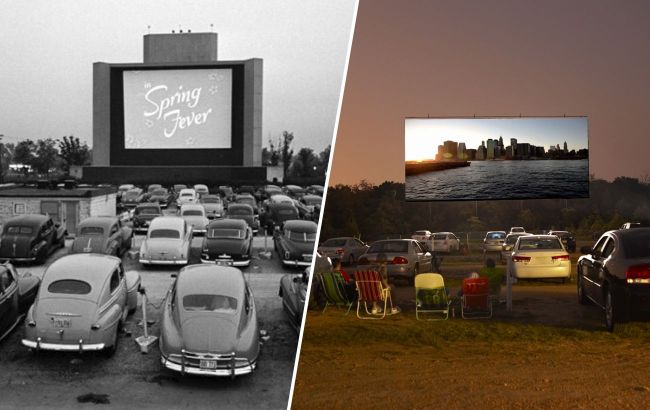First drive-in theater story: Why its creator never became millionaire
 When and how was the first drive-in theater in history opened (Collage RBC-Ukraine)
When and how was the first drive-in theater in history opened (Collage RBC-Ukraine)
Every year on June 6th, we celebrate Drive-In Movie Day. It's worth noting that the first drive-in theater opened almost a hundred years ago in the USA. RBC-Ukraine shares the story of the founder of such a theater and how the whole network developed.
The first drive-in theater opened on June 6, 1933, in Camden, New Jersey. Its founder was Richard Milton Hollingshead Jr.
In the early 1930s, Richard worked as a general manager of sales for his father's automotive chemical company, Whiz Auto Product. According to one story, his mother, a larger woman, found it uncomfortable to sit in a regular movie theater.
So Richard began experimenting in his own driveway in Camden, using his car, a 1928 Kodak movie projector, and two sheets nailed between two trees as a screen. He later added ramps to each parking space so viewers could elevate the front of their cars to see the screen without blocking it for others.
On August 6, 1932, he filed for a patent, and in May 1933, he received documents for his invention. With three investors, his cousin John Smith, Edward Ellis, and Oliver Willets, he founded a company called Park-it-Theatres. The initial investment was $30,000.
Construction began when the patent was officially registered on May 16. In less than three weeks, the new theater was built. Their Drive-In Theater, covering 1.6 acres, opened on Admiral Wilson Boulevard in the town of Pennsauken.
Admission was 25 cents per person and per car. It's worth noting that nowadays, in the USA, the average price in such theaters is around $9. The first movie screened was "Wives Beware" starring Adolphe Menjou.
In 1935, Hollingshead sold this theater and opened another one. The license for the concept was transferred to another company, but they encountered problems collecting royalties.
In 1950, the patent was declared invalid. In fact, the inventor of this leisure concept didn't profit from his theater invention except for the ticket sales for 2 years.

One of the first drive-in theaters (Photo: Pinterest)
Later, such theaters began to open all over the United States, and the trend spread to various countries around the world, eventually reaching Ukraine. These theaters could be opened without the inventor's permission.
One of the largest was the All-Weather Drive-In in Copiague, New York, which had 2,500 parking spaces, a children's playground, and a full-service restaurant on a 28-acre site.
Drive-in theaters primarily showed B-movies, meaning not the best films from Hollywood, but some theaters screened the same films as regular cinemas.
The popularity of drive-in theaters skyrocketed after World War II, reaching its peak from the late 1950s to the mid-60s, when there were about 5,000 theaters across the country.
Cars became an icon of American culture and a typical weekend destination not only for parents and children but also for teenage couples seeking privacy.
However, since then, rising real estate prices, especially in suburban areas, combined with the increase in indoor theaters and the growth of video rentals, have stifled the drive-in industry. Today, there are fewer than 500 drive-in theaters in the United States.
Sources: Wikipedia, DayToday, History.

